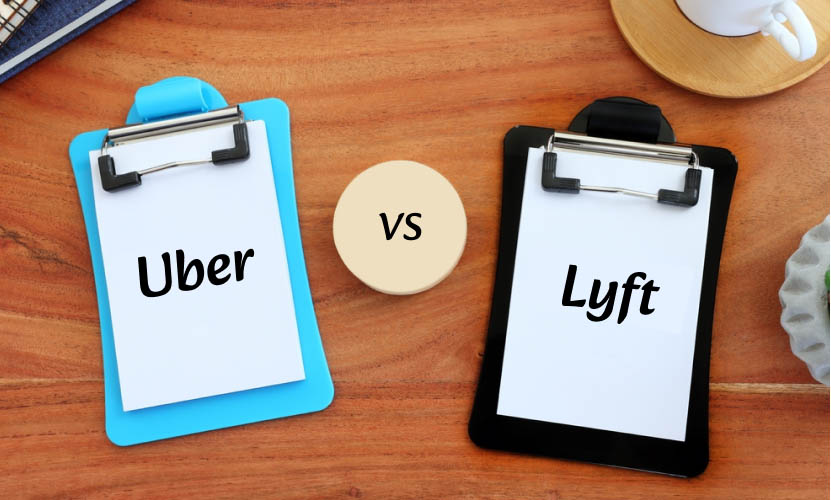
The Uber vs. Lyft fight is never-ending. Each has a competitive advantage over the other, making both close rivals in the US ride-hailing market. The industry is currently growing at a rapid pace, and these industry giants have been major contributors to its growth.
In fact, Uber dominates the US market, with Lyft closely following behind. The ride-hailing market in the US is projected to reach US$72.61bn by 2030, driven by a significant increase in demand for online taxi services. While the market is more saturated than ever, Uber and Lyft still remain unbeatable.
The secret behind these two ride-hailing giants’ success lies in their competitive pricing and excellent services. Both of them have some similarities but also some stark differences that make them unique. They both excel in different business areas and focus on their unique offerings. Their aim, however, is the same: providing the best services to their riders and drivers.
Keeping this in mind, we’ve decided to evaluate how riders and drivers perceive these companies. In pursuit of that, we are going to have a complete Uber vs Lyft comparison. The comparison will take place from the riders’ and drivers’ perspectives and will be done on numerous criteria.
Overview of Uber Business
Uber is one of the first and most popular ride-hailing service apps. The company was launched in San Francisco in 2009 and now serves more than 70 countries and 10,500 cities around the world.
It is a platform that connects riders with drivers. This means, unlike a traditional cab-booking company, Uber doesn’t own a fleet of cars or hire drivers as employees. Rather, they join the platform on a contract basis and earn directly from riders by offering taxi services. The platform earns a commission from the drivers’ earnings.
It has also expanded its offerings to include food delivery and freight transport services, enabling it to diversify its revenue streams. Still, ride-hailing services have been a core offering and have recently helped the company generate gross bookings of $42.0bn to $43.5bn in the first quarter of 2025. With such an increment, Uber is for sure a top market player in the cab-hailing sector.
Uber has made a strong impact on the global ride-hailing market, inspiring entrepreneurs from around the world. It’s also the icing on the cake: entrepreneurs can build their taxi booking business with the Uber clone. Quick launch with the utmost flexibility to build a solution, eliminating the hassle of starting from scratch.
Overview of Lyft Business
Lyft is another popular ride-hailing platform in the United States and Canada. The company started in 2012, just four years after Uber. Being one of the top runners, Lyft gives close competition to Uber in the US market. However, the company has restricted itself to North American borders, serving the US and Canada specifically.
The business strategy of Lyft also runs on a two-sided marketplace model. However, Lyft’s area of focus is cab booking only. It doesn’t offer food or courier delivery. This way, they channel their attention to improving their core offering rather than diversifying to multiple verticals.
Despite its limited market reach, Lyft generated gross bookings of $4.05 billion to $4.20 billion in the first quarter of 2025. The company strategically balances its services to meet riders’ needs, maintaining a competitive edge. Hence, Lyft is the second-biggest cab-booking firm in the US.
Its success has proved that, despite a saturated market, a ride-hailing business can make its place. Starting your own taxi business is easier than ever with the Lyft clone app. This ready-made solution enables quick launching and costs relatively less than building an app from scratch.
Moving on. Let’s mark some major differences between Uber and Lyft.
Uber vs Lyft: Pricing Comparison
There are some major differences between Uber’s and Lyft’s pricing strategies. Here’s a detailed breakdown.
Uber’s Pricing Strategy
The average ride fare on Uber is around $27.50 in the US. However, this varies by city and vehicle type. The total fare is calculated using base rates plus prices based on time and distance. The surge pricing factor during peak demand times also significantly fluctuates the fares.
Moreover, in some cities, Uber does not offer up-front fare estimates. Rather, it calculates the total charge when the ride ends.
Lyft’s Pricing Strategy
Lyft’s average fare is approximately $22.75, which consists of base fare charges and calculations based on total distance traveled and minutes of travel time. Similar to Uber, Lyft’s pricing strategy also incorporates dynamic pricing, which increases the base rates.
While Lyft’s pricing seems slightly lower compared to Uber’s, it also charges higher in some urban areas. Additionally, Uber’s dynamic pricing provides more flexibility during off-peak hours, offering a competitive edge with a wide range of ride options.
Uber vs Lyft: Business Expansion
While both of them are working in the same field, they have different business expansion strategies. Let’s quickly analyze how their routes differ when it comes to growing their operations.
Uber’s Expansion Strategy
Uber primarily focuses on geographical and service diversification. It has adapted to the local market, employed aggressive marketing, and formed strategic partnerships to expand its global reach.
Uber now operates as a publicly listed company on the NYSE. It dominates not just a global ride-hailing market, but also food delivery, freight transportation, and other on-demand segments as well.
Lyft’s Expansion Strategy
Lyft has a more localized approach, focusing primarily on the North American markets. However, it has set its feet in international markets, particularly in Europe, by acquiring FreeNow.
Like Uber, Lyft is also a publicly traded company with its IPO launching in March 2019. While Lyft’s geographical expansion seems a little lagging behind its close competitor, it’s increasingly focusing on new innovations and sustainable traveling with its commitment to be 100% EV-based platform by the end of 2030.
This commitment seems easier to achieve as it mainly serves countries where EVs are more prevalent. However, Uber also aims to go all-EV by 2040, and looking at its global position, Uber seems to have upperhand in this regard despite a decade of difference in the timeline.
Till now, we’ve been evaluating Uber and Lyft from their business perspective. Now, let’s dive deeper and assess how these ride-hailing giants serve their prime users: riders and drivers.
Uber vs Lyft: A Side-By-Side Comparison From The Users’ Perspective
Uber and Lyft are two cab-booking giants. On the surface, Uber seems to have an advantage over Lyft due to its global market dominance. However, there are some things where Lyft excels. For example, it’s more focused on a driver-friendly experience.
Here, we have attempted to provide a comprehensive comparison between Uber and Lyft from different users’ perspectives. You will learn how these platforms serve their riders and drivers, as well as what differentiates them from one another.
Let’s start by comparing from the riders’ point of view.
Comparing Uber vs Lyft From the Riders’ Perspective
Riders are the end users who book cabs from these two platforms. These users play an essential role in a cab-booking business. Therefore, it’s essential to know how Uber’s and Lyft’s services differ for riders.
| Comparison Criteria | Uber | Lyft |
|---|---|---|
| Availability | Available in about 70 countries & 10,500 cities worldwide | Provide services in 644 US cities & 12 Canadian cities |
| App Experience | Clean, business-like UIs that ease ride booking | Almost similar features to Uber but has casual, friendly branding |
| Ride Options |
|
|
| Waiting Time Frame | 2-5 minutes for standard rides and may vary for premium options like Uber Black | Around 2 minutes for standard rides and may differ for premium ride options. |
| Subscription Plan | Uber One: $9.99/month or $96/year |
|
| Tipping Culture | Optional with 30-day tipping window | Optional but encouraged with a 72-hour tipping window |
| Loyalty Rewards | Riders have to purchase subscriptions to get loyalty rewards | Riders earn points for every dollar spent on the app and get rewards by spending them |
| Safety Features |
|
|
Comparing Uber vs Lyft From Drivers’ Perspective
Since drivers are treated as individual users rather than contractual employees, they also deserve consideration in the Uber vs Lyft comparison. So, here’s how these two cab-booking giants differ from the drivers’ perspective.
| Comparison Criteria | Uber | Lyft |
|---|---|---|
| Registration Process | Simple; it only takes a few minutes | Pretty much the same as Uber |
| Background Check | Takes 3-5 business days | It might take a few days or several weeks |
| Competition | Higher as more driver availability | Lower compared to Uber |
| Earning Potential | Higher in most cities due to huge demand | Competitive, but may be lower than Uber |
| Commission | Range from 15% to 30%, depending on many factors | Not more than 30% |
| Tips | Receive fewer tips compared to Lyft drivers | Tips are more frequent due to in-app prompts |
| Reward Programs | Uber Pro (cashback on EV & gas refilling, preferred area selection, and more) | Lyft Rewards (cashback on EV & gas refilling, discounts on auto maintenance, and more) |
| Safety Features |
|
|
| Driver Support | More robust support system; offers in-person assistance in some locations | More personalized support system |
| Vehicle Requirements | Stricter standards | More relaxed standards than Uber |
Final Verdict: Which Is Better, Uber or Lyft?
The comparison between Uber and Lyft revealed that Uber has an advantage on many grounds. Here’s a short summary for busy entrepreneurs.
- Uber has a strong pricing strategy that includes competitive rates and dynamic pricing that ensures profitability for drivers and business owners.
- Uber’s expansion strategy focuses on globalization and service diversification through food delivery, freight transportation, and more.
- Widespread global presence ensures more availability, offering higher revenue opportunities.
- Providing top-notch user experience, loyalty programs, safety features, and other functionalities instill great customer satisfaction, lowering churn rate, and increasing retention.
- To retain drivers on its platform, the company offers higher earning potential, competitive commission rates, and extensive driver support.
The strong, distinctive factors like these make Uber a more popular ride-hailing platform, beating Lyft in this comparison.
A Perfect Taxi App Is Just a Few Conversations Away! Check out Our Ready-Made Solution and Let Us Know Your Requirements.
How Much Does It Cost To Build A Ride-Hailing App?
A rough estimation of app development expenses would range from $15,000 to $50,000. However, determining the exact cost of creating an app like Uber is a challenging task, as it involves considering numerous factors.
Depending on these factors, the development cost can significantly increase or decrease beyond the given range. Let’s discuss these factors and try to understand how they affect the cost:
Technology Selection
The choice of technology has a significant impact on the cost. iOS app development usually costs more than Android due to the higher hardware requirements in iOS devices. That said, building an app on both platforms can increase the cost even further. A hybrid platform like React Native may be cost-effective, but you might have to compromise on quality.
Features & Functionalities
The more features you want and the more enhanced functionality you need, the higher your app development cost will be. The choice of features and functionalities depends on the extent of experience you want to offer to your users. It’s wise to start with basic features and scale your application as you go.
Third-Party Integrations
The most successful ride-hailing apps often utilize various third-party tools to enhance their functionalities. Entrepreneurs often overlook the cost of third-party integrations because they typically don’t know what tools their app might require. To get an exact cost estimation, you should consider consulting an experienced app developer.
Maintenance & Upgradation
Post-launch maintenance greatly affects our development costs, but it’s also essential. Developers usually offer app maintenance services that include basic bug fixes and performance enhancements. However, this might vary depending on company policy or your chosen package. Consult with developers to determine the cost of this factor in your development.
Closing Thoughts
While Uber and Lyft both seem like they stand on the same level, they share some stark differences. Hope this article has offered a clear Uber vs Lyft comparison, allowing you to derive useful insights that will help in your future cab-booking business.
Now that you know your ideal model, it’s time to find the right solution. As one of the prominent on-demand app development firms, Elluminati offers a cutting-edge white label taxi app solution to entrepreneurs who wish to start their taxi business. Our innovative product is highly customizable, enabling you to rebrand your platform easily. Contact us to learn more.











